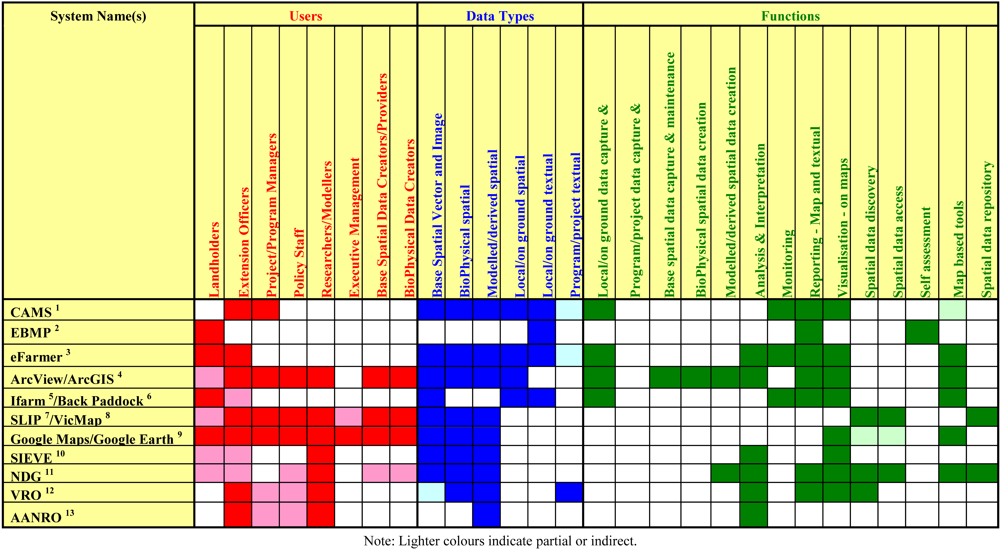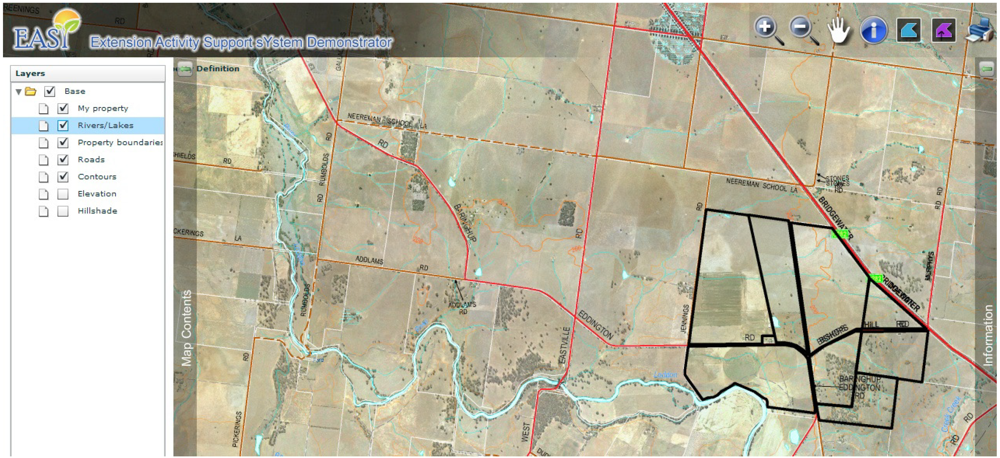Extension Activity Support System (EASY): A Web-Based Prototype for Facilitating Farm Management
Abstract
:1. Introduction
 |
2. Overview
3. Methodology: Consultation and Evaluation

4. Results
4.1. Review of Existing Agricultural and NRM Software/Data Repositories to Inform EASY Concept Design
4.2. Development of Broad Principles and Vision for EASY Concept
4.2.1. Broad Principles for EASY Concept Design
4.2.2. EASY Vision Statement
“EASY will be a freely available, open, extensible online system where researchers, agricultural program managers, agricultural consultants, extension staff and landholders create and exchange spatial and other information for use in agricultural planning and management. EASY will be a platform that enables collaborative knowledge-building for improving the productivity and sustainability of agricultural practice.”
4.3. Establishing the EASY System Characteristics
4.3.1. Potential Users
4.3.2. System Characteristics Based on User Needs and Requirements


4.4. EASY Concept Design Details: System Functionality for Different Users
4.4.1. Researcher/Program Manager Functions
4.4.1.1. Content Authoring and Packaging of Information
4.4.1.2. Provision of Executable Models
4.4.1.3. Provision of Modelled Outputs
4.4.1.4. Provision of Remotely Sensed Products and Temporal Change Datasets
4.4.1.5. Create Template Datasets and Data Capture Tools
4.4.2. Extension Officer, Consultant, Landholder Functions
4.4.2.1. Security and Access Control
4.4.2.2. Searching and Information Discovery
4.4.2.3. Map Viewing, Query and Printing of Base Datasets
4.4.2.4. Data Editing
4.4.2.5. Data Download
4.4.2.6. Temporal Viewing and Analysis Tools
4.4.2.7. Reporting

4.4.2.8. Contributed Observational and Monitoring Information
4.4.3. General System Functionality
4.4.3.1. Connections and Accessibility
4.4.3.2. Usability and Expertise
4.4.3.3. Customisation and Extensibility
4.4.3.4. Access and Security
4.5. Data and Information
4.5.1. Spatial Data
4.5.1.1. Dataset Externally Hosted—OpenGIS Services—Client and Server
4.5.1.2. Hosted Spatial Datasets
4.5.2. Hosted Non-Spatial Datasets
5. Discussion
- To succeed, agricultural DSSs require involvement and continual improvement by farmers, agricultural consultants, and researchers.
- The goal of agricultural DSSs should not be to produce an algorithmically optimal solution, but instead should enable users to arrive at individually designed solutions based on a combination of data, experience, and intuition.
- A delivery plan must be an integral part of DSS creation. The delivery plan should involve developers and scientists as well as end-users and must include a funding plan that will maintain the DSS beyond initial delivery.
6. Summary and Conclusions
References
- McCown, R. Learning to bridge the gap between scientific decision support and the practice of farming: Evolution in paradigms of model-based research and intervention from design to dialogue. Aust. J. Agric. Res. 2001, 52, 549–571. [Google Scholar]
- McCown, R.; Parton, K. Learning from the historical failure of farm management models to aid farm management practice. 2. Three systems approaches. Aust. J. Agric. Res. 2006, 57, 157–172. [Google Scholar] [CrossRef]
- Ewert, F.; van Ittersum, M.; Bezlepkina, I.; Therond, O.; Andersen, E.; Belhouchette, H.; Bockstaller, C.; Brouwer, F.; Heckelei, T.; Janssen, S.; et al. A methodology for enhanced flexibility of integrated assessment in agriculture. Environ. Sci. Policy 2009, 12, 546–561. [Google Scholar] [CrossRef]
- Binder, C.; Feola, G.; Steinberger, J. Considering the normative, systemic, and procedural dimensions in indicator-based sustainability assessments in agriculture. Environ. Impact Assess. Rev. 2010, 30, 71–81. [Google Scholar] [CrossRef]
- Bezlepkina, I.; Reidsma, P.; Sieber, S.; Helming, K. Editorial: Integrated assessment of sustainability of agricultural systems and land use: Methods, tools, and application. Agric. Syst. 2011, 104S, 105–109. [Google Scholar]
- van Ittersum, M.; Ewert, F.; Heckelei, T.; Wery, J.; Alkan Olsson, J.; Andersen, E.; Bezlepkina, I.; Brouwer, F.; Donatelli, M.; Flichman, G.; Olsson, L.; Rizzoli, A.; van der Wal, T.; Wien, J.; Wolf, J. Integrated assessment of agricultural systems—A component-based framework for the European Union (SEAMLESS). Agric. Syst. 2008, 96, 150–165. [Google Scholar]
- Wery, J.; Langeveld, J. Introduction to the EJA special issue on cropping system design: New methods and new challenges. Eur. J. Agron. 2010, 32, 1–2. [Google Scholar]
- Cros, M.; Duru, M.; Garcia, F.; Martin-Clouaire, R. A biophysical dairy farm model to evalaute rotational grazing management strategies. Agronomy 2003, 23, 105–122. [Google Scholar]
- Moore, A.; Robertson, M.; Routley, R. Evaluation of the water use efficiency of alternative farm practices at a range of spatial and temporal scales: A conceptual framework and a modelling approach. Agric. Syst. 2011, 104, 162–174. [Google Scholar]
- CAMS (Catchment Activity Management System) website. Available online: http://www.dse.vic.gov.au/land-management/regional-data-net-catchment-activity-management (accessed on 7 November 2011).
- Environmental Farm Plan website. Available online: http://www.environmentalfarmplan.org.au/ (accessed on 7 November 2011).
- Roberts, A.; Park, G.; Melland, A.; Miller, I. Trialling a web-based spatial information management tool with Land Managers in Victoria. Aust. J. Environ. Manag. 2009, 91, 523–531. [Google Scholar]
- ESRI website. Available online: http://www.esri.com/software/arcgis/arcgis-for-desktop/index.html (accessed on 7 November 2011).
- ifarm website. Available online: http://www.eagri.com.au/ (accessed on 7 November 2011).
- Back Paddock website. Available online: http://www.backpaddock.com.au/ (accessed on 7 November 2011).
- SLIP website. Available online: https://www2.landgate.wa.gov.au/web/guest/home (accessed on 4 January 2012).
- VicMap website. Available online: http://www.land.vic.gov.au/ (accessed on 12 May 2011).
- GoogleEarth website. Available online: http://earth.google.com/ (accessed on 7 November 2011).
- GoogleMaps website. Available online: http://maps.google.com.au/ (accessed on 7 November 2011).
- Stock, C.; Bishop, I.; O’Connor, A.; Chen, T.; Pettit, C.; Aurambout, J.-P. SIEVE: Collaboration decision-making in an immersive online environment. Cartogr. Geogr. Inf. Sci. 2008, 35, 133–144. [Google Scholar]
- NDG website. Available online: http://www.spatialvision.com.au/index.php/national-data-grid-ndg.html (accessed on November 2011).
- VRO website. Available online: http://new.dpi.vic.gov.au/vro (accessed on 7 November 2011).
- Australian Agriculture and Natural Resources Online (AANRO). Available online: http://www.rgc.org.au/knowledgebase/AANRO (accessed on 7 November 2011).
- Lacy, J. Cropcheck: Farmer benchmarking participatory model to improve productivity. Agric. Syst. 2011, 104, 562–571. [Google Scholar]
- Vaysières, J.; Vigne, M.; Alary, V.; Lecomte, P. Integrated participatory modeling of actual farms to support policy making on sustainable intensification. Agric. Syst. 2011, 104, 146–161. [Google Scholar]
- le Gal, P.-Y.; Dugué, P.; Faure, G.; Novak, S. How does research address the design of innovative agricultural production systems at the farm level? A review. Agric. Syst. 2011, 104, 714–728. [Google Scholar]
- Giller, K.; Leeuwis, C.; Andriesse, W.; Brouwer, A.; Frost, P.; Hebinck, P.; Heikonig, I.; van Ittersum, M.; Koning, N.; Rubne, R.; et al. Competing claims on natural resources: What role for science? Ecol. Soc. 2008, 13, p. 34. Available online: http;//www.ecologyandsociety.org.vol13/ iss2/art34 (accessed on 7 November 2011).
- Hochman, Z.; Carberry, P. Emerging consensus on desirable characteristics of tools to support farmers’ management of climate risk in Australia. Agric. Syst. 2011, 441–450. [Google Scholar]
- le Gal, P.-Y.; Mérot, A.; Moulin, C.; Navarrete, M.; Wery, J. A modeling framework to support farmers in designing innovative agricultural production systems. Environ. Model. Softw. 2010, 25, 258–268. [Google Scholar]
- Thysen, I. Agriculture in the information society. J. Agric. Eng. Res. 2000, 76, 297–303. [Google Scholar]
- Chan, T.; Farrell, S.; Frankish, G. The National Data Grid: A Development Model for Grid Cell Data Infrastructure. In Proceedings of the FIG Congress 2010 (International Federation of Surveyors), Sydney, Australia, 11–16 April 2010.
- Arnott, D.; Pervan, G. A critical analysis of decision support systems research. J. Inf. Technol. 2005, 20, 67–87. [Google Scholar]
- Cartwright, W. Desktop Analysis and Review of Spatial Information Products and Technologies that have Application at the Farm and Catchment Scale; Report to the Department of Primary Industries, DPI: Melbourne, Australia, 2007.
- Fitzpatrick, B.; Neale, T. Overview of Farm Mapping Software in Australia, Rural Industries Research and Development Corporation; RIRDC Publication No 08/038, Project No CTF-1A; Rural Industries Research and Development Corporation: Kingston (ACT), Australia, 2008.
- Pettit, C.J.; Cartwright, W.; Bishop, I.; Park, G.; Kemp, O. Enhancing Web-Based Farm Management Software Through the Use of Visualisation Technologies. In Proceedings of the MODSIM07: International Congress on Modelling and Simulation, Christchurch, New Zealand, 10–13 December 2007.
© 2012 by the authors; licensee MDPI, Basel, Switzerland. This article is an open-access article distributed under the terms and conditions of the Creative Commons Attribution license (http://creativecommons.org/licenses/by/3.0/).
Share and Cite
Lowell, K.; Smith, L.; Miller, I.; Pettit, C.; Seymour, E. Extension Activity Support System (EASY): A Web-Based Prototype for Facilitating Farm Management. Future Internet 2012, 4, 42-64. https://doi.org/10.3390/fi4010042
Lowell K, Smith L, Miller I, Pettit C, Seymour E. Extension Activity Support System (EASY): A Web-Based Prototype for Facilitating Farm Management. Future Internet. 2012; 4(1):42-64. https://doi.org/10.3390/fi4010042
Chicago/Turabian StyleLowell, Kim, Lindsay Smith, Ian Miller, Christopher Pettit, and Eloise Seymour. 2012. "Extension Activity Support System (EASY): A Web-Based Prototype for Facilitating Farm Management" Future Internet 4, no. 1: 42-64. https://doi.org/10.3390/fi4010042
APA StyleLowell, K., Smith, L., Miller, I., Pettit, C., & Seymour, E. (2012). Extension Activity Support System (EASY): A Web-Based Prototype for Facilitating Farm Management. Future Internet, 4(1), 42-64. https://doi.org/10.3390/fi4010042




